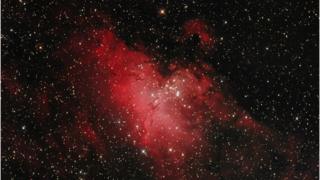 Image copyright Manfred_Konrad
Image copyright Manfred_Konrad A team of astrochemists has recreated deep space in the laboratory and discovered that cosmic dust is more complex than previously thought.
Twelve years of research at Heriot-Watt University has led to the conclusion each grain of interstellar dust behaves “like a badly assembled cherry cake “.
They were surprised to find that ice collects into lumps on the space dust rather than uniform layers.
Researchers said the discovery could hold the key to life in the universe.
Tiny flecks of space dust create spectacular cosmic formations such as the Eagle Nebula but they are more than just good looking.
They control the process that forms stars and create the organic molecules from which life may evolve.
In the deep cold of space, hydrogen and oxygen atoms combine to create water molecules on the surface of the dust grains.
At more than 250 degrees below the point at which water freezes you would expect it to take the form of immobile ice.
So Prof Martin McCoustra’s team were surprised to find water was still on the move, diffusing across the surface of simulated dust grains at a temperature of 18 Kelvin.
That’s just 18 degrees above absolute zero, the point at which everything stops moving.
In his laboratory at Heriot-Watt, Prof McCoustra has recreated the low temperatures and almost non-existent pressure of interstellar space.
He says the moving water molecules came as “a complete surprise”.
“Everyone assumed that at those temperatures water was a couch potato,” he says.
“It was made on the surface and stayed where it was made. It didn’t diffuse.”
“We’ve now shown … in a few hours it moves nanometres.
“And even if you go colder it’s still moving on measurable timescales.”
Existing theories about ice on space dust lend themselves to another food-based analogy: the layers of an onion.
But instead of ice building neatly in layer upon layer the experiments suggest something more complex.
“It agglomerates, it collects into lumps,” the professor says.
“So you’ve got lumps of water and bits of clean surface on which your next set of materials come down.
“Instead of having an onion the first couple of layers now sort of resemble a very badly assembled cherry cake.
“The water is the cherries that have sunk to the bottom of the baking tin and the cake is the rest of the material that’s then been deposited after the water starts growing. “
The energy for the diffusion process comes from light and cosmic rays.
Why does it all matter?
It could hold the key to life in the universe.
The extreme cold deposits other molecules such as carbon monoxide on to the dust grains.
These can combine with more hydrogen to create organic molecules.
As the molecules become more complex they could be carried by comets to seed life elsewhere.
That’s because relatively simple molecules can be transformed into amino acids when irradiated.
This is the ‘panspermia’ theory.
An alternative model suggests life arose on Earth when lightning and radiation provided the energy to transform complex molecules into amino acids but the two theories are not exclusive.
Prof McCoustra and his team used complex and expensive equipment to recreate the interstellar conditions although he characterises it as a “fancy fridge” .
The simulated dust grain is a piece of copper with a layer of silica grown on it, held inside a stainless steel vessel pumped to an ultra-high vacuum.
The research was funded by the UK Science and Technologies Facilities Council, the Engineering and Physical Sciences Research Center, the university and the European Community Marie Curie program.
Is this an accurate model of the real thing?
We could find out soon.
Heriot-Watt’s researchers are part of an international network which has won observation time on the forthcoming James Webb Space Telescope (JWST) .
The IceAge project wants to know how ices form on the dust between star systems.
The JWST has been designed to see far more than even the existing Hubble telescope which has been observing the Universe from Earth orbit for almost 30 years.
An Ariane 5 rocket is due to put it into space in 2021. The mission is designed to see further and in more detail than ever before.
It is expected to give us deeper insight into how stars form and life began.







GIPHY App Key not set. Please check settings